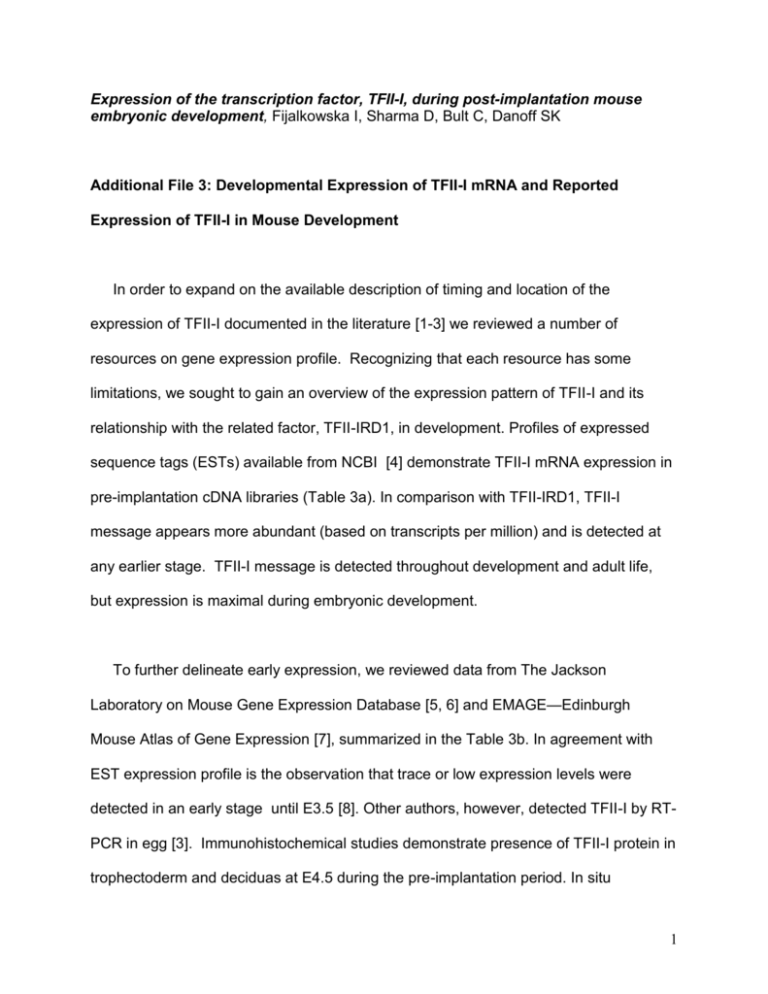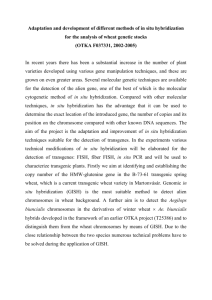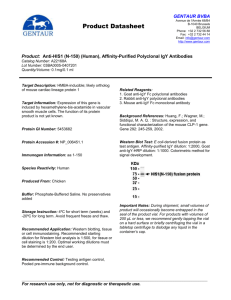Expression of the transcription factor, TFII-I, in post
advertisement

Expression of the transcription factor, TFII-I, during post-implantation mouse embryonic development, Fijalkowska I, Sharma D, Bult C, Danoff SK Additional File 3: Developmental Expression of TFII-I mRNA and Reported Expression of TFII-I in Mouse Development In order to expand on the available description of timing and location of the expression of TFII-I documented in the literature [1-3] we reviewed a number of resources on gene expression profile. Recognizing that each resource has some limitations, we sought to gain an overview of the expression pattern of TFII-I and its relationship with the related factor, TFII-IRD1, in development. Profiles of expressed sequence tags (ESTs) available from NCBI [4] demonstrate TFII-I mRNA expression in pre-implantation cDNA libraries (Table 3a). In comparison with TFII-IRD1, TFII-I message appears more abundant (based on transcripts per million) and is detected at any earlier stage. TFII-I message is detected throughout development and adult life, but expression is maximal during embryonic development. To further delineate early expression, we reviewed data from The Jackson Laboratory on Mouse Gene Expression Database [5, 6] and EMAGE—Edinburgh Mouse Atlas of Gene Expression [7], summarized in the Table 3b. In agreement with EST expression profile is the observation that trace or low expression levels were detected in an early stage until E3.5 [8]. Other authors, however, detected TFII-I by RTPCR in egg [3]. Immunohistochemical studies demonstrate presence of TFII-I protein in trophectoderm and deciduas at E4.5 during the pre-implantation period. In situ 1 hybridization studies focused primarily on the central nervous system, detailing a complex pattern of regional expression at E13.5 and post-natal day 0 [9]. In situ hybridization studies in E14 mouse embryo suggested ubiquitous RNA expression, but with regional variation in intensity [10]. Table 3a. Expression profiles of TFII-I and TFII-IRD1 by analysis of EST counts. Data extracted from EST Profile Viewer (NCBI) [4, 11]. Developmental stages are defined as noted. Numerical data represent the number of transcripts per million (TPM). These numbers reflect a low-end estimate for the presence of a given transcript at a particular developmental stage, but suggest that TFII-I and TFII-IRD1 are expressed earlier than VEGFR-2. DEVELOPMENTAL STAGE TFII-I (Mm.261570) TFII-IRD1 (Mm.332735) 0 153 Pre-implantation 202 63 Post-implantation 255 34 Mid-gestation 342 69 Late-gestation 468 89 Neonate 168 102 Post natal 150 27 Adult 152 34 Egg 2 Table 3b. Reported Expression of TFII-I in Mouse Development. DEVELOPMENTAL STAGE STATUS METHOD OF DETECTION REFERENCE Unfertilized egg; Maternally expressed, Present Present Indirect immunofluorescence, RT-PCR [3] Zygote: pronuclei; 2-cell stage: nuclei, cytoplasm; polar body nucleus; 8-16-cell and morula: inner cell mass (ICM), trophectoderm; ED3.5, early blastocyst: ICM, trophoectoderm E4.5 embryo: nuclei and cytoplasm of ICM, and trophoblast cells. Decidual cells: nuclei and cytoplasm Present Present Present Present Oocyte, 2-cell to 8-cell embryo, morula; ED3.5 blastocyst ED4.5 blastocyst and ICM Trace or weak Moderate Trace or weak RT-PCT ED3.5 ICM, trophoectoderm Strong, present ED8.5: diffused expression pattern Present In situ hybridization, LacZ staining of gene-trap embryos [13] ED10.5: central nervous sytem Ambiguous RNA in situ [9] ED12.5: embryo: developing jaw, presumptive tooth regions Present In situ hybridization [14] Present RNA in situ [9] Present RNA in situ [9] WISH [8] [12] ED13.5: embryo; head, central nervous system, cerebral cortex, corpus striatum, thalamus, hypothalamus, midbrain, hindbrain, ventricular layer, spinal cord, P0: head, central nervous system, cerebral cortex, cerebellum, corpus striatum, hindbrain, spinal cord, cranial ganglion, dorsal root ganglion, tooth. 3 References 1. 2. 3. 4. 5. 6. 7. 8. 9. 10. 11. 12. 13. LA Perez Jurado, YK Wang, R Peoples, A Coloma, J Cruces, U Francke: A duplicated gene in the breakpoint regions of the 7q11.23 Williams-Beuren syndrome deletion encodes the initiator binding protein TFII-I and BAP-135, a phosphorylation target of BTK. Hum Mol Genet 1998, 7:325-34. SK Danoff, HE Taylor, S Blackshaw, S Desiderio: TFII-I, a candidate gene for Williams syndrome cognitive profile: parallels between regional expression in mouse brain and human phenotype. Neuroscience 2004, 123:931-8. B Enkhmandakh, N Bitchevaia, F Ruddle, D Bayarsaihan: The early embryonic expression of TFII-I during mouse preimplantation development. Gene Expr Patterns 2004, 4:25-8. DL Wheeler, T Barrett, DA Benson, SH Bryant, K Canese, V Chetvernin, DM Church, M Dicuccio, R Edgar, S Federhen, et al: Database resources of the National Center for Biotechnology Information. Nucleic Acids Res 2008, 36:D13-21. MGIWS Gene Expression Database (GXD), The Jackson Laboratory, Bar Harbor, Maine. World Wide Web (URL: http://www.informatics.jax.org). [July 2005.]: In: Book. City. CM Smith, JH Finger, TF Hayamizu, IJ McCright, JT Eppig, JA Kadin, JE Richardson, M Ringwald: The mouse Gene Expression Database (GXD): 2007 update. Nucleic Acids Res 2007, 35:D618-23. S Venkataraman, P Stevenson, Y Yang, L Richardson, N Burton, TP Perry, P Smith, RA Baldock, DR Davidson, JH Christiansen: EMAGE--Edinburgh Mouse Atlas of Gene Expression: 2008 update. Nucleic Acids Res 2008, 36:D860-5. RP Guo G.: Transcription Factor Dynamics in the preimplantation embryo. In: Book Transcription Factor Dynamics in the preimplantation embryo. City; 2008. PA Gray, H Fu, P Luo, Q Zhao, J Yu, A Ferrari, T Tenzen, D-i Yuk, EF Tsung, Z Cai, et al: Mouse Brain Organization Revealed Through Direct GenomeScale TF Expression Analysis. Science 2004, 306:2255-2257. YK Wang, LA Perez-Jurado, U Francke: A mouse single-copy gene, Gtf2i, the homolog of human GTF2I, that is duplicated in the Williams-Beuren syndrome deletion region. Genomics 1998, 48:163-170. EW Sayers, T Barrett, DA Benson, SH Bryant, K Canese, V Chetvernin, DM Church, M DiCuccio, R Edgar, S Federhen, et al: Database resources of the National Center for Biotechnology Information. Nucleic Acids Res 2009, 37:D5-15. T Yoshikawa, Y Piao, J Zhong, R Matoba, MG Carter, Y Wang, I Goldberg, MS Ko: High-throughput screen for genes predominantly expressed in the ICM of mouse blastocysts by whole mount in situ hybridization. Gene Expr Patterns 2006, 6:213-24. B Enkhmandakh, AV Makeyev, L Erdenechimeg, FH Ruddle, NO Chimge, MI Tussie-Luna, AL Roy, D Bayarsaihan: Essential functions of the WilliamsBeuren syndrome-associated TFII-I genes in embryonic development. Proc Natl Acad Sci U S A 2009, 106:181-6. 4 14. A Ohazama, PT Sharpe: TFII-I gene family during tooth development: candidate genes for tooth anomalies in Williams syndrome. Dev Dyn 2007, 236:2884-8. 5







